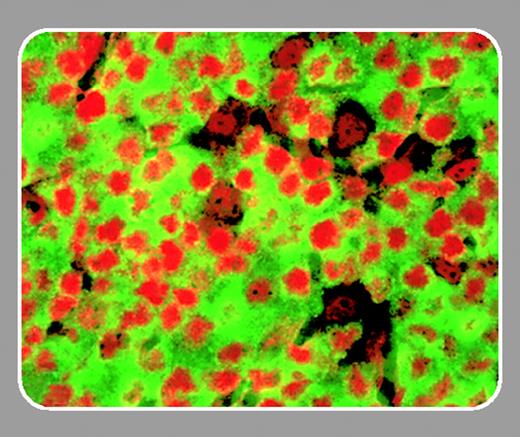For many years, the bifurcation between Hodgkin disease and non-Hodgkin lymphomas appeared settled: the former comprised an easily recognizable lymphoma category and the latter was a heterogenous group of T- and B-cell neoplasias. The clinically aggressive B-cell lymphomas were regarded as a rather fuzzy group of tumors composed of more or less large neoplastic cells. As is often the case in pathology, this view turned out to be naive. Hodgkin disease is presently grouped into 2 subcategories: “lassical,” which current opinion regards as germinal-center–derived in nearly all cases (rare T-cell cases excluded), and “lymphocyte predominant,” which comprises cases that are believed to always be of germinal-center origin. Large-scale gene expression studies profiling diffuse, large B-cell lymphomas revealed different expression patterns, called signatures, that mimicked the steps in normal B-cell ontogeny.
Molecular cytogenetics strongly suggest that primary mediastinal B-cell lymphoma is a disease of its own in the large B-cell lymphoma group, and studies recently produced the startling idea that mediastinal B-cell lymphoma and classical Hodgkin disease might be pathogenetically related because they share characteristic chromosomal aberrations, especially gains on 2p and 9p.
Two very recent studies based on gene-expression profiling, including the work of Savage and colleagues (in this issue, page 3871), give substantial support to this emerging concept. Rosenwald et al1 define mediastinal B-cell lymphoma as a recognizable entity different from the “germinal center” and from the “activated” group, as previously defined by these authors by a characteristic signature. Surprisingly, probing cell lines on a previously published Lymphochip comprising 12 196 cDNAs revealed a similarity between Hodgkin cell lines and both the putatively mediastinal cell line Karpas1106 and whole tumor tissue–derived RNA from mediastinal B-cell lymphomas. In essence, the conclusions drawn from this gigantic set of data are confirmed by conclusions drawn by Savage and colleagues from their own data based on the U133A and U133B Affymetrix chips. Again, mediastinal B-cell lymphoma had a signature differing from those of other large B-cell lymphomas, including several with secondary mediastinal involvement. In addition, the profiles of mediastinal B-cell lymphoma resembled those of Hodgkin cell lines. Both studies constitute an important step forward. Both papers contain a wealth of new genes of interest that may now may be studied in detail, including confirmation on the protein level. Proof-of-principle examples are given by Rosenwald et al (eg, the MAL protein, previously published as a characteristic of mediastinal B-cell lymphomas, in Reed-Sternberg cells) and by Savage et al (eg, the nuclear localization of c-REL protein in mediastinal B-cell lymphoma, a feature that had been recently shown in Hodgkin cases with gains of 2p, including the REL locus).
The next step to be taken is the expression profiling of Reed-Sternberg cells isolated from the ex vivo situation. This is essential in order to discern the “true” situation in classical Hodgkin disease, uninfluenced by effects of clonal progression and selection in vitro. Only then will it be worth-while to embark on molecular biologic studies further illuminating the common mechanisms in tumorigenesis and mechanisms explaining the unquestionable differences such as histology, gender predominance, and spread, which for so long have clouded the relationship between mediastinal B-cell lymphoma and classical Hodgkin disease.


This feature is available to Subscribers Only
Sign In or Create an Account Close Modal